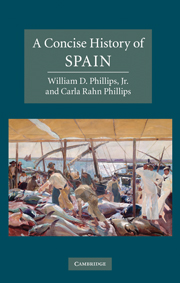Book contents
- Frontmatter
- Contents
- List of illustrations
- List of maps
- Preface
- 1 The land and its early inhabitants
- 2 Ancient legacies
- 3 Diversity in medieval Spain
- 4 The rise of Spain to international prominence
- 5 Spain as the first global empire
- 6 Toward modernity: from the Napoleonic invasion to Alfonso XIII
- 7 The struggle for the Spanish soul: Republic, civil war, and dictatorship
- 8 New Spain, new Spaniards: European, democratic, and multi-cultural
- Chronology and rulers
- Guide to further information
- Index
- Titles in the series
- References
6 - Toward modernity: from the Napoleonic invasion to Alfonso XIII
Published online by Cambridge University Press: 05 August 2012
- Frontmatter
- Contents
- List of illustrations
- List of maps
- Preface
- 1 The land and its early inhabitants
- 2 Ancient legacies
- 3 Diversity in medieval Spain
- 4 The rise of Spain to international prominence
- 5 Spain as the first global empire
- 6 Toward modernity: from the Napoleonic invasion to Alfonso XIII
- 7 The struggle for the Spanish soul: Republic, civil war, and dictatorship
- 8 New Spain, new Spaniards: European, democratic, and multi-cultural
- Chronology and rulers
- Guide to further information
- Index
- Titles in the series
- References
Summary
Joseph Bonaparte was arguably the best of the Bonaparte clan, and Napoleon undoubtedly hoped that the Spanish people would accept him as a welcome replacement for the feckless Bourbons. He was wrong. By the time that Joseph arrived at the frontier, a spontaneous revolt against the French invasion had already begun. The rising began in Madrid on May 2, in reaction to news that the royal family had left for France. General Murat put down a riot in the Puerta del Sol quickly and brutally, using the Mameluke cavalry that Napoleon had recruited in Egypt. Given the long Spanish history of conflict with Muslim forces, the sight of turbaned horsemen charging a crowd of men and women in the heart of Madrid had a shocking effect. The next day, Murat's soldiers executed the supposed leaders of the riot on the hill of Príncipe Pío, at the western edge of Madrid near the royal palace. Various Spanish artists would paint their interpretations of those two actions, but the versions that history remembers are two arresting canvases by Goya, which capture the events in all their horror. In The Charge of the Mamelukes on the 2nd of May, the mad look on the face of the horseman in the center of the composition, and the tangle of bloodied bodies and enraged citizens in front of him, evoke the violent movement, confusion, and savagery of the confrontation.
- Type
- Chapter
- Information
- A Concise History of Spain , pp. 206 - 245Publisher: Cambridge University PressPrint publication year: 2010

